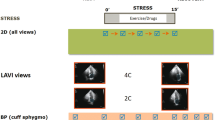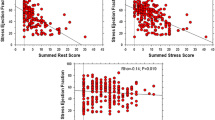Summary
In patients with coronary heart disease (CHD) it is important to differentiate between reversible and irreversible left ventricular (LV) asynergy. Therefore global and regional LV function was investigated in the postextrasystolic beat (PES) and after isosorbide dinitrate (ISDN). In 24 patients LV angiograms were performed before and after ISDN. The ejection fraction (EF) was determined in a sinus beat and in PES. Regional LV performance was measured by the shortening of the length axis and six short hemiaxes. In 12 patients with normal LV function at rest EF increased from .72±.04 (±1 SD) to .77±.04 (P<0.05) after ISDN and rose further to .81±.02 in the PES (P<0.05). In 12 patients with CHD and LV asynergy EF increased from .43±.12 to .47±.13 after ISDN (P<0.05) and rose further to .57±.13 in the PES (P<0.02). After ISDN 23/39 asynergic axes improved, 15/39 axes did not change, 1/39 axis decreased its shortening by 12%. In the PES 26/39 axes improved, 6/39 axes did not change; 7/39 axes showed less shortening, presumably due to a systolic shift of blood into dyskinetic regions with LV scar.
It is concluded: The PES affects viable myocardium more than does ISDN; the PES is easier to perform and permits a more precise distinction between reversible and irreversible LV dyskinesis.
Zusammenfassung
Bei Patienten mit koronarer Herzkrankheit ist die Differenzierung zwischen reversibler und irreversibler linksventrikulärer Asynergie wichtig. Die globale und regionale linksventrikuläre Funktion wurde daher im postextrasystolischen Schlag und nach Isosorbitdinitrat (ISDN) untersucht. Bei 24 Patienten wurden linksventrikuläre Angiogramme vor und nach ISDN-Gabe angefertigt. Die Austreibungsfraktion (EF) wurde in einem Sinusschlag und in einem postextrasystolischen Schlag bestimmt. Die regionale Wandbewegung wurde beurteilt nach der Verkürzung von sechs Halbachsen und der Längsachse.
Bei 12 Patienten mit normaler linksventrikulärer Funktion in Ruhe erhöhte sich die EF von 72±4% (±1 SD) nach der Gabe von ISDN auf 77±4% (p<0,05) und erhöhte sich weiter auf 81±2% im postextrasystolischen Schlag (p<0,05). Bei 12 Patienten mit koronarer Herzkrankheit und linksventrikulärer Asynergie stieg die Austreibungsfraktion von 43±12% nach der Gabe von ISDN auf 47±13% (p<0,05) und erreichte im postextrasystolischen Schlag 57±13% (p<0,02). Nach ISDN verbesserten 23 von 39 asynergen Achsen ihre Bewegung, 15 von 39 Achsen veränderten sich nicht, und eine Achse verminderte ihre Verkürzung um 12%. Im postextrasystolischen Schlag zeigten 26 von 39 Achsen eine Verbesserung an, 6 von 39 Achsen zeigten keine wesentliche Änderung. 7 Achsen verkürzten sich weniger als im Normalschlag, was wahrscheinlich auf eine systolische Pendelbewegung von Blut in dyskinetische linksventrikuläre Abschnitte mit bindegewebiger Narbe zurückzuführen sein dürfte.
Es wird gefolgert: Der postextrasystolische Schlag hat auf funktionstüchtiges Myokard einen größeren Effekt als ISDN. Der postextrasystolische Schlag ist technisch leichter durchzuführen und gestattet wahrscheinlich eine genauere Unterscheidung zwischen reversibler und irreversibler linksventrikulärer Dyskinesie als die Gabe von Isosorbitdinitrat.
Similar content being viewed by others
References
Chatterjee, K., H. J. C. Swan, W. W. Parmley, H. Sustaita, H. S. Marcus, J. Matloff: Influence of direct myocardial revascularization of left ventricular asynergy and function in patients with coronary heart disease. Circulation47, 276–286 (1973).
Banka, V. S., M. M. Bodenheimer, R. Shah, R. H. Helfant: Intervention ventriculography. Comperative value of nitroglycerin, post-extrasystolic potentiation and nitroglycerin plus postextrasystolic potentiation. Circulation53, 632–637 (1976).
Bodenheimer, M. M., V. S. Banka, G. A. Hermann, R. G. Traut, H. Pasdas, R. H. Helfant: Reversible asynergy. Histopathologic and electrographic correlations in patients with coronary artery disease. Circulation53, 792–796 (1976).
Helfant, R. H.: Nitroglycerin: new concepts about an old drug. Am. J. Med.60, 905–909 (1976).
Schwarz, F., R. Ensslen, J. Thormann, M. Sesto: Effects of nitroglycerin, postextrasystolic potentiation and pacing-induced ischaemia on wall motion in patients with ischemic heart disease. British Heart J.39, 44–52 (1977).
Greene, D. H., R. Carlisle, C. Grant, I. L. Bunnell: Estimation of left ventricular volume by one-plane cineangiography. Circulation35, 61–91 (1967).
Katus, H., H. C. Mehmel, K. von Olshausen, H. Zebe, W. Kübler: Die Abhängigkeit der postextrasystolischen Potenzierung von der Vorzeitigkeit der Extrasystole und der Dauer der postextrasystolischen Pause beim menschlichen Herzen. Zeitschrift für Kardiologie67, 192 (1978) (abstr.).
Markis, J. E., P. F. Cohn, B. H. Roberts, C. L. Skalton, E. H. Sonnenblick: Effect of varying the coupling-interval on postextrasystolic potentiation. Clin. Res.24, 229 (1976) (abstr.).
Klausner, S. C., R. A. Ratshin, J. V. Tyberg, H. A. Lappin, K. Chatterjee, W. W. Parmley: The similarity of changes in segmental contraction patterns induced by postextrasystolic potentiation and nitroglycerin. Circulation54, 615–623 (1976).
Popio, K. A., R. Gorlin, D. Bechtel, J. A. Levine: Postextrasystolic potentiation as a predictor of potential myocardial viability: preoperative analyses compared with studies after coronary bypass surgery. Am. J. Cardiol.39, 944–953 (1977).
Chatterjee, K., W. W. Parmley, W. Ganz, J. Forrester, P. Walinsky, C. Crexells, H. J. C. Swan: Hemodynamic and metabolic responses to vasodilator therapy in acute myocardial infarction. Circulation48, 1183–1193 (1973).
Dyke, S. H., C. W. Urschel, E. H. Sonnenblick, R. Gorlin, P. F. Cohn: Detection of latent function in acutely ischemic myocardium in the dog. Circulation Res.36, 490–497 (1975).
Helfant, R. H., R. Pine, S. G. Meister, M. S. Feldmann, R. G. Traut, V. S. Banka: Nitroglycerin to unmask reversible asynergy. Correlation with post coronary bypass ventriculography. Circulation35, 61–69 (1967).
Author information
Authors and Affiliations
Additional information
With 7 figures and 1 table
These investigations were supported by a grant from the Bundesministerium für Forschung und Technologie (BMFT) im Rahmen des Projekts DISMED 18.
Rights and permissions
About this article
Cite this article
Mehmel, H.C., Katus, H., Bassemir, K.R. et al. Comparison between the effect of postextrasystolic potentiation and the effect of nitrates on left ventricular function for the differentiation between reversible and irreversible left ventricular asynergy. Basic Res Cardiol 75, 390–399 (1980). https://doi.org/10.1007/BF01907586
Received:
Issue Date:
DOI: https://doi.org/10.1007/BF01907586




